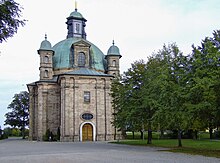Pilgrimage Church Maria Hilf (Freystadt)
The pilgrimage church Maria Hilf in Freystadt near Neumarkt in the Upper Palatinate is an important central building of the German high baroque. The church is together with the Freystadt monastery on a wide flat meadow north of the gates of the small town.
history
Towards the end of the Thirty Years' War , the two shepherd boys Hans Popp and Hans Steinmetz built a small chapel made of wood and clay on the Rosswiese in the north of Freystadt. There they put up a picture of Mary given by Sarah Frank. Due to the high influx of pilgrims, the construction of a stone chapel began soon afterwards, in which a carved miraculous image was placed. The consecration took place in 1670. An extension of the church planned due to the large number of pilgrims was abandoned in favor of a new building, not least because of construction defects. The local landlord Ferdinand Lorenz Franz Xaver Graf Tilly, whose family ( descendants of General Tilly ) had been enfeoffed with rich benefices in the Upper Palatinate, which had been conquered by Bavaria, acted as the builder .
Between 1700 and 1710 a central building was built according to the plans of Giovanni Antonio Viscardi , which is vaulted by a dome with a lantern and surrounded by four small corner towers. The stucco work of the baroque church was made by Pietro Francesco Appiani . Hans Georg Asam created the frescoes from the life of Mary with the support of his sons Cosmas Damian and Egid Quirin .
A Franciscan monastery was built next to the church from 1712 to 1714 according to plans by the Franciscan brother and architect Philipp Plank to take care of the pilgrimage. Even before the Reformation , the order had a monastery on the nearby Möningerberg .
25 years after construction, the church's plans served as a model for the Dresden Frauenkirche .
In 1802 the monastery was dissolved by secularization in Bavaria . The church was supposed to be demolished, but was preserved thanks to the intervention of Freiherr von Griesenbeck, who had found the grave of one of his ancestors in the church. In 1835 the Franciscans also returned. The church had suffered badly from damage and dilapidation and therefore, especially with regard to the furnishings, only limited conclusions about the original condition. The high altar, for example, dates from the 1950s.
organ
The organ was built by Volkmar Krätzer with a neo-baroque prospect . The slider chests -instrument has 15 registers on two manuals and pedal . The playing and register actions are mechanical.
|
|
|
|||||||||||||||||||||||||||||||||||||||||||||||||||||||||||||||||||||||||||||||||||||||||||||||
- Coupling : II / I, I / P, II / P
Individual evidence
- ↑ Basic information on the pilgrimage church
- ↑ On an adventure tour in Freystadt - KDFB Diözesanverband invited to "alumni meeting" . In: Diocese of Eichstätt . ( bistum-eichstaett.de [accessed on May 4, 2017]).
- ↑ Information on the organ
Web links
Coordinates: 49 ° 12 ′ 14 ″ N , 11 ° 19 ′ 36 ″ E




